Interprofessional Collaboration in Healthcare
VerifiedAdded on 2020/06/04
|17
|4388
|59
AI Summary
This assignment delves into the complexities of interprofessional collaboration within healthcare, focusing on integrated mental health care in low- and middle-income countries. It examines the challenges and opportunities presented by integrating mental health services within existing healthcare structures. The analysis draws upon literature discussing barriers to effective collaboration, including differing professional cultures, communication issues, and lack of clear leadership roles. Furthermore, it explores policy frameworks like the Patient Protection and Affordable Care Act (USA) and the Health and Social Care Act (UK) that aim to promote interprofessional teamwork and integrated care delivery.
Contribute Materials
Your contribution can guide someone’s learning journey. Share your
documents today.

INTERPROFESSIONAL LEARNING IN PRACTICE
TOPIC: INTERPROFESSIONAL LEARNING IN PRACTICE
STUDENT NAME:
STUDENT ID:
PROFESSOR NAME:
TOPIC: INTERPROFESSIONAL LEARNING IN PRACTICE
STUDENT NAME:
STUDENT ID:
PROFESSOR NAME:
Secure Best Marks with AI Grader
Need help grading? Try our AI Grader for instant feedback on your assignments.

Table of Contents
Introduction...........................................................................................................................3
Issues for a London Locality.................................................................................................4
Identifying key variables that determine health for Digital-first public health.....................4
Describing impacts of inequality on health for Digital-first public health............................4
Explaining major challenges facing this issue in the UK and London borough.................5
Describing steps considered in London locality to address the big ambition....................6
Problems in process of implementation and lifestyle impact on public health issue.........6
Key facets of health promotion in relation to Digital-first public health..............................7
Critical Review......................................................................................................................7
Concept of inter-professional working in contemporary health and social care................7
Advantages and disadvantages of inter-professional working in practice.........................9
Outlining national policies that recommend inter-professional working...........................11
Reviewing applied factors with effectiveness in achieving Digital-first ambition.............12
Conclusion..........................................................................................................................13
Reference List:....................................................................................................................15
2 | P a g e
Introduction...........................................................................................................................3
Issues for a London Locality.................................................................................................4
Identifying key variables that determine health for Digital-first public health.....................4
Describing impacts of inequality on health for Digital-first public health............................4
Explaining major challenges facing this issue in the UK and London borough.................5
Describing steps considered in London locality to address the big ambition....................6
Problems in process of implementation and lifestyle impact on public health issue.........6
Key facets of health promotion in relation to Digital-first public health..............................7
Critical Review......................................................................................................................7
Concept of inter-professional working in contemporary health and social care................7
Advantages and disadvantages of inter-professional working in practice.........................9
Outlining national policies that recommend inter-professional working...........................11
Reviewing applied factors with effectiveness in achieving Digital-first ambition.............12
Conclusion..........................................................................................................................13
Reference List:....................................................................................................................15
2 | P a g e
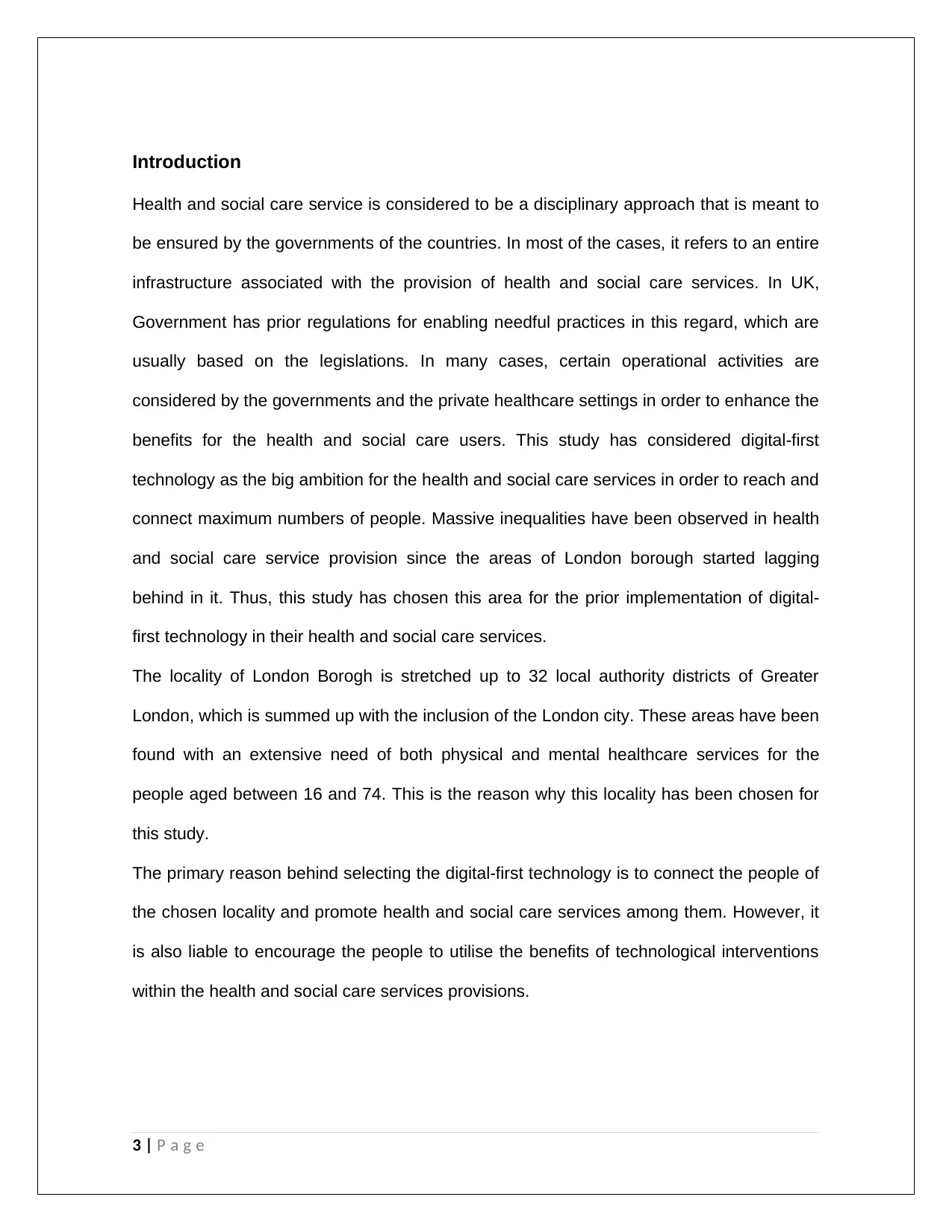
Introduction
Health and social care service is considered to be a disciplinary approach that is meant to
be ensured by the governments of the countries. In most of the cases, it refers to an entire
infrastructure associated with the provision of health and social care services. In UK,
Government has prior regulations for enabling needful practices in this regard, which are
usually based on the legislations. In many cases, certain operational activities are
considered by the governments and the private healthcare settings in order to enhance the
benefits for the health and social care users. This study has considered digital-first
technology as the big ambition for the health and social care services in order to reach and
connect maximum numbers of people. Massive inequalities have been observed in health
and social care service provision since the areas of London borough started lagging
behind in it. Thus, this study has chosen this area for the prior implementation of digital-
first technology in their health and social care services.
The locality of London Borogh is stretched up to 32 local authority districts of Greater
London, which is summed up with the inclusion of the London city. These areas have been
found with an extensive need of both physical and mental healthcare services for the
people aged between 16 and 74. This is the reason why this locality has been chosen for
this study.
The primary reason behind selecting the digital-first technology is to connect the people of
the chosen locality and promote health and social care services among them. However, it
is also liable to encourage the people to utilise the benefits of technological interventions
within the health and social care services provisions.
3 | P a g e
Health and social care service is considered to be a disciplinary approach that is meant to
be ensured by the governments of the countries. In most of the cases, it refers to an entire
infrastructure associated with the provision of health and social care services. In UK,
Government has prior regulations for enabling needful practices in this regard, which are
usually based on the legislations. In many cases, certain operational activities are
considered by the governments and the private healthcare settings in order to enhance the
benefits for the health and social care users. This study has considered digital-first
technology as the big ambition for the health and social care services in order to reach and
connect maximum numbers of people. Massive inequalities have been observed in health
and social care service provision since the areas of London borough started lagging
behind in it. Thus, this study has chosen this area for the prior implementation of digital-
first technology in their health and social care services.
The locality of London Borogh is stretched up to 32 local authority districts of Greater
London, which is summed up with the inclusion of the London city. These areas have been
found with an extensive need of both physical and mental healthcare services for the
people aged between 16 and 74. This is the reason why this locality has been chosen for
this study.
The primary reason behind selecting the digital-first technology is to connect the people of
the chosen locality and promote health and social care services among them. However, it
is also liable to encourage the people to utilise the benefits of technological interventions
within the health and social care services provisions.
3 | P a g e
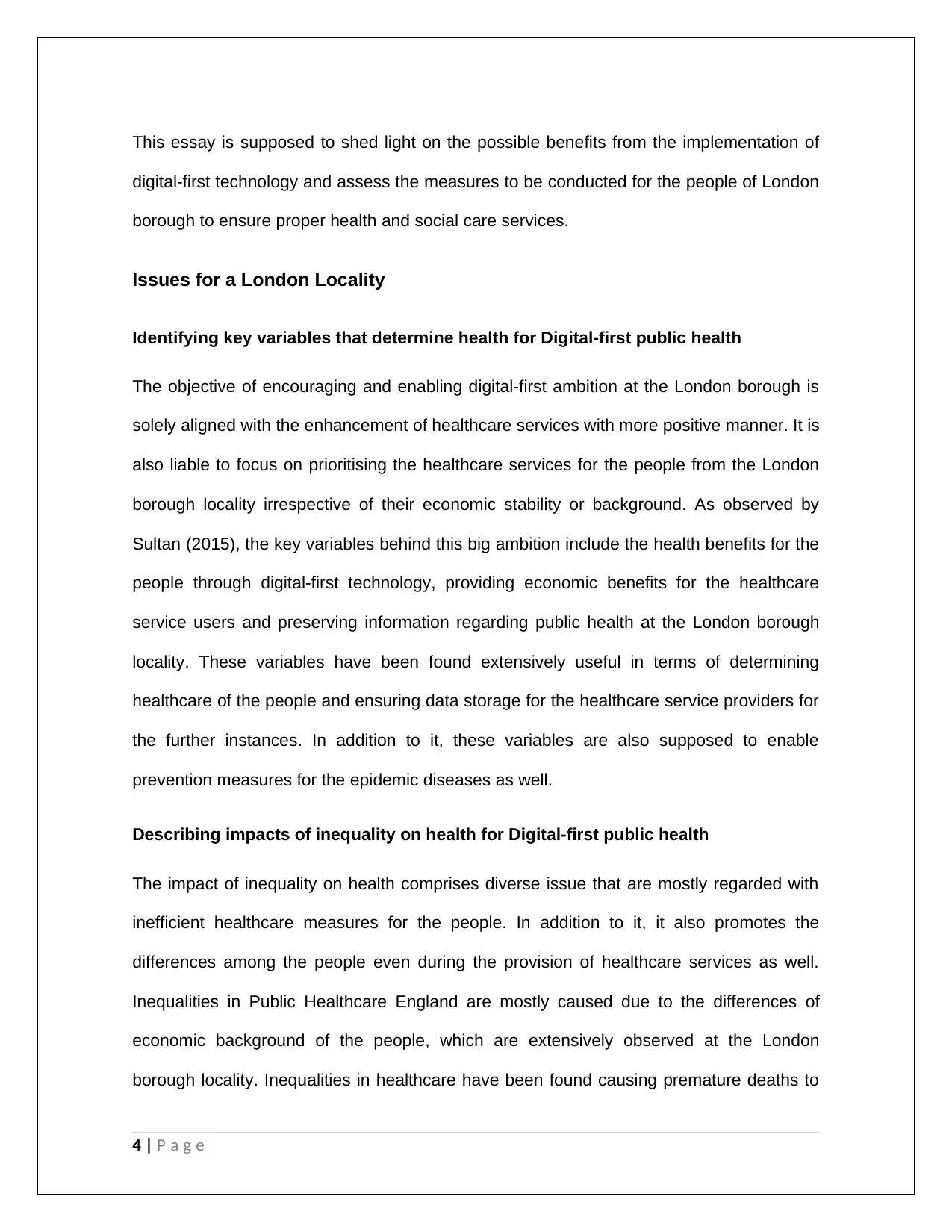
This essay is supposed to shed light on the possible benefits from the implementation of
digital-first technology and assess the measures to be conducted for the people of London
borough to ensure proper health and social care services.
Issues for a London Locality
Identifying key variables that determine health for Digital-first public health
The objective of encouraging and enabling digital-first ambition at the London borough is
solely aligned with the enhancement of healthcare services with more positive manner. It is
also liable to focus on prioritising the healthcare services for the people from the London
borough locality irrespective of their economic stability or background. As observed by
Sultan (2015), the key variables behind this big ambition include the health benefits for the
people through digital-first technology, providing economic benefits for the healthcare
service users and preserving information regarding public health at the London borough
locality. These variables have been found extensively useful in terms of determining
healthcare of the people and ensuring data storage for the healthcare service providers for
the further instances. In addition to it, these variables are also supposed to enable
prevention measures for the epidemic diseases as well.
Describing impacts of inequality on health for Digital-first public health
The impact of inequality on health comprises diverse issue that are mostly regarded with
inefficient healthcare measures for the people. In addition to it, it also promotes the
differences among the people even during the provision of healthcare services as well.
Inequalities in Public Healthcare England are mostly caused due to the differences of
economic background of the people, which are extensively observed at the London
borough locality. Inequalities in healthcare have been found causing premature deaths to
4 | P a g e
digital-first technology and assess the measures to be conducted for the people of London
borough to ensure proper health and social care services.
Issues for a London Locality
Identifying key variables that determine health for Digital-first public health
The objective of encouraging and enabling digital-first ambition at the London borough is
solely aligned with the enhancement of healthcare services with more positive manner. It is
also liable to focus on prioritising the healthcare services for the people from the London
borough locality irrespective of their economic stability or background. As observed by
Sultan (2015), the key variables behind this big ambition include the health benefits for the
people through digital-first technology, providing economic benefits for the healthcare
service users and preserving information regarding public health at the London borough
locality. These variables have been found extensively useful in terms of determining
healthcare of the people and ensuring data storage for the healthcare service providers for
the further instances. In addition to it, these variables are also supposed to enable
prevention measures for the epidemic diseases as well.
Describing impacts of inequality on health for Digital-first public health
The impact of inequality on health comprises diverse issue that are mostly regarded with
inefficient healthcare measures for the people. In addition to it, it also promotes the
differences among the people even during the provision of healthcare services as well.
Inequalities in Public Healthcare England are mostly caused due to the differences of
economic background of the people, which are extensively observed at the London
borough locality. Inequalities in healthcare have been found causing premature deaths to
4 | P a g e
Secure Best Marks with AI Grader
Need help grading? Try our AI Grader for instant feedback on your assignments.
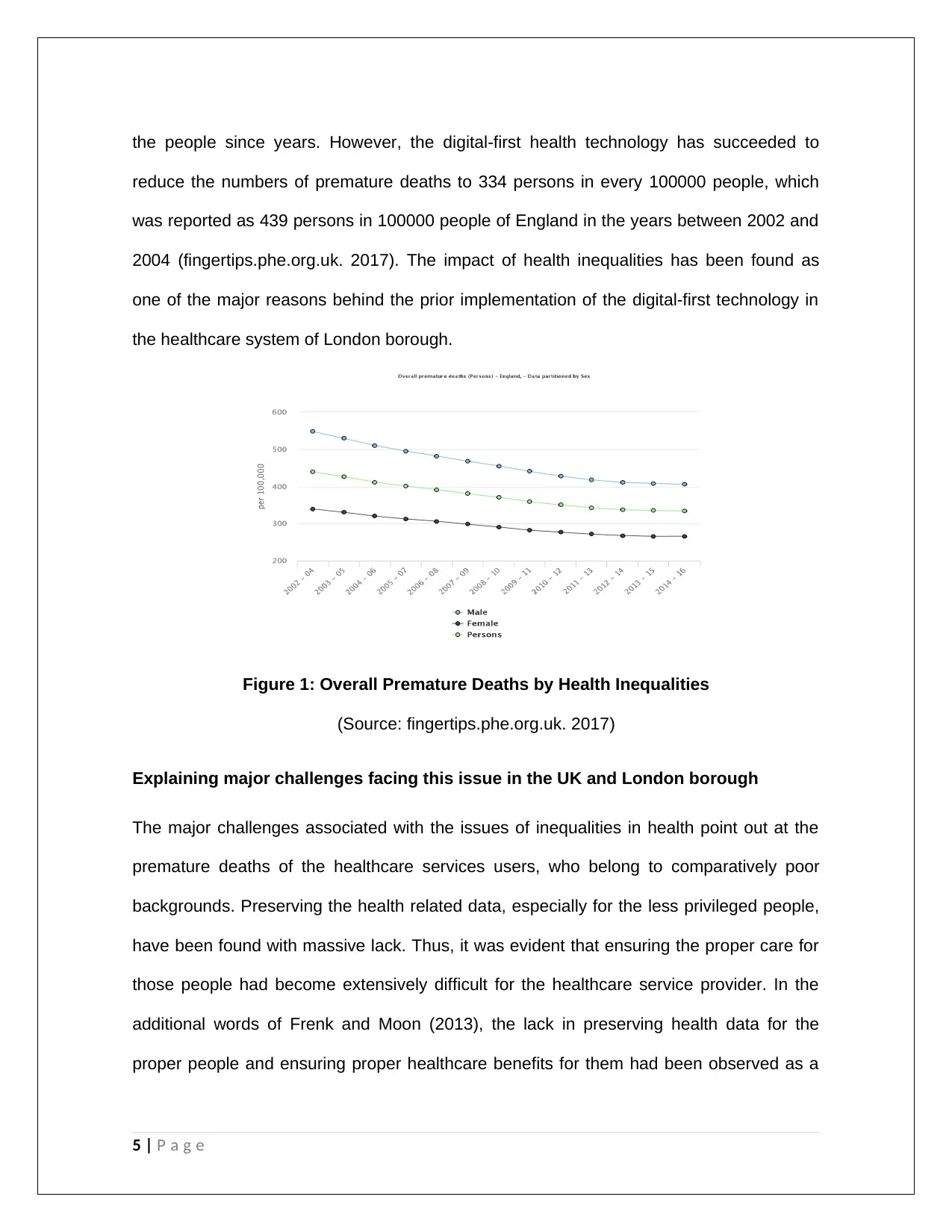
the people since years. However, the digital-first health technology has succeeded to
reduce the numbers of premature deaths to 334 persons in every 100000 people, which
was reported as 439 persons in 100000 people of England in the years between 2002 and
2004 (fingertips.phe.org.uk. 2017). The impact of health inequalities has been found as
one of the major reasons behind the prior implementation of the digital-first technology in
the healthcare system of London borough.
Figure 1: Overall Premature Deaths by Health Inequalities
(Source: fingertips.phe.org.uk. 2017)
Explaining major challenges facing this issue in the UK and London borough
The major challenges associated with the issues of inequalities in health point out at the
premature deaths of the healthcare services users, who belong to comparatively poor
backgrounds. Preserving the health related data, especially for the less privileged people,
have been found with massive lack. Thus, it was evident that ensuring the proper care for
those people had become extensively difficult for the healthcare service provider. In the
additional words of Frenk and Moon (2013), the lack in preserving health data for the
proper people and ensuring proper healthcare benefits for them had been observed as a
5 | P a g e
reduce the numbers of premature deaths to 334 persons in every 100000 people, which
was reported as 439 persons in 100000 people of England in the years between 2002 and
2004 (fingertips.phe.org.uk. 2017). The impact of health inequalities has been found as
one of the major reasons behind the prior implementation of the digital-first technology in
the healthcare system of London borough.
Figure 1: Overall Premature Deaths by Health Inequalities
(Source: fingertips.phe.org.uk. 2017)
Explaining major challenges facing this issue in the UK and London borough
The major challenges associated with the issues of inequalities in health point out at the
premature deaths of the healthcare services users, who belong to comparatively poor
backgrounds. Preserving the health related data, especially for the less privileged people,
have been found with massive lack. Thus, it was evident that ensuring the proper care for
those people had become extensively difficult for the healthcare service provider. In the
additional words of Frenk and Moon (2013), the lack in preserving health data for the
proper people and ensuring proper healthcare benefits for them had been observed as a
5 | P a g e
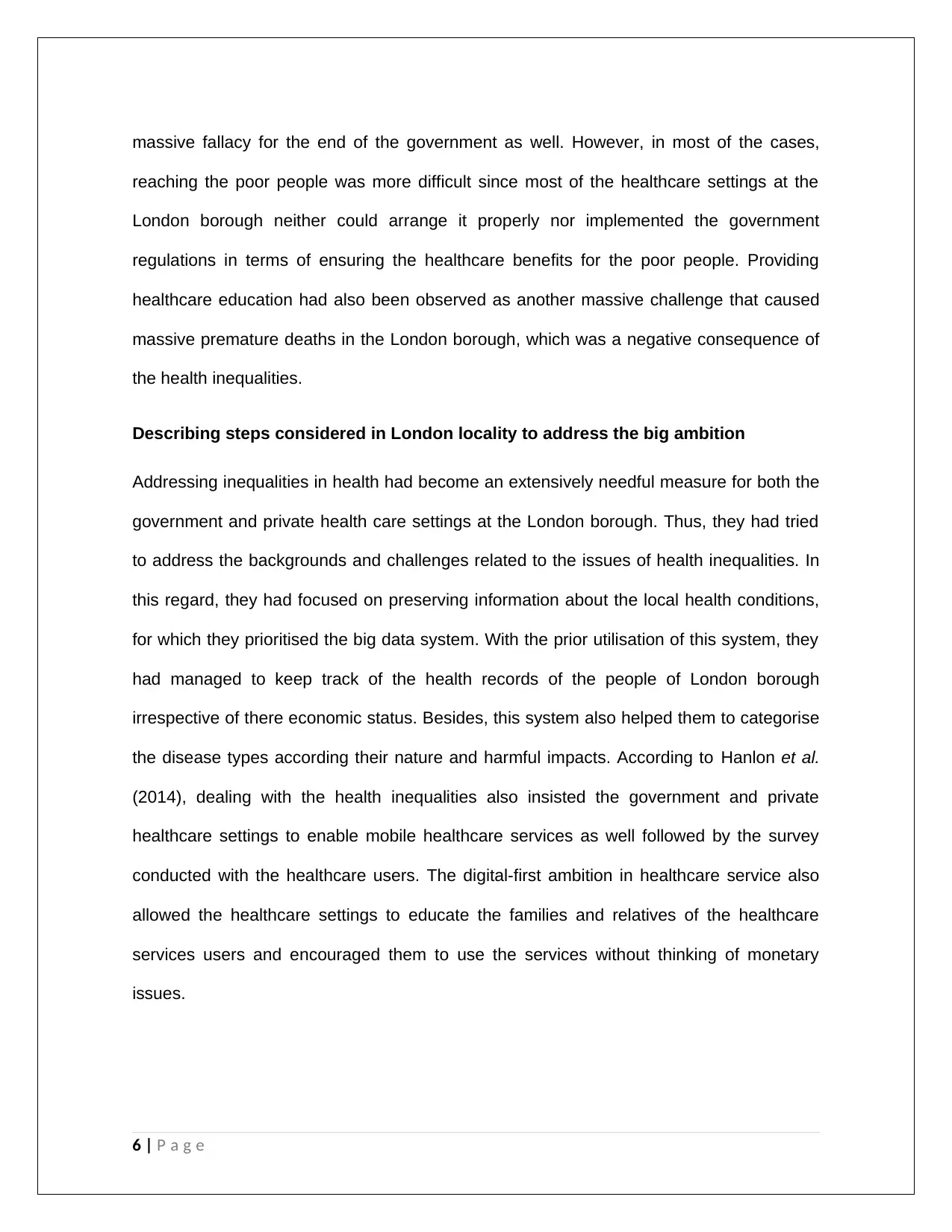
massive fallacy for the end of the government as well. However, in most of the cases,
reaching the poor people was more difficult since most of the healthcare settings at the
London borough neither could arrange it properly nor implemented the government
regulations in terms of ensuring the healthcare benefits for the poor people. Providing
healthcare education had also been observed as another massive challenge that caused
massive premature deaths in the London borough, which was a negative consequence of
the health inequalities.
Describing steps considered in London locality to address the big ambition
Addressing inequalities in health had become an extensively needful measure for both the
government and private health care settings at the London borough. Thus, they had tried
to address the backgrounds and challenges related to the issues of health inequalities. In
this regard, they had focused on preserving information about the local health conditions,
for which they prioritised the big data system. With the prior utilisation of this system, they
had managed to keep track of the health records of the people of London borough
irrespective of there economic status. Besides, this system also helped them to categorise
the disease types according their nature and harmful impacts. According to Hanlon et al.
(2014), dealing with the health inequalities also insisted the government and private
healthcare settings to enable mobile healthcare services as well followed by the survey
conducted with the healthcare users. The digital-first ambition in healthcare service also
allowed the healthcare settings to educate the families and relatives of the healthcare
services users and encouraged them to use the services without thinking of monetary
issues.
6 | P a g e
reaching the poor people was more difficult since most of the healthcare settings at the
London borough neither could arrange it properly nor implemented the government
regulations in terms of ensuring the healthcare benefits for the poor people. Providing
healthcare education had also been observed as another massive challenge that caused
massive premature deaths in the London borough, which was a negative consequence of
the health inequalities.
Describing steps considered in London locality to address the big ambition
Addressing inequalities in health had become an extensively needful measure for both the
government and private health care settings at the London borough. Thus, they had tried
to address the backgrounds and challenges related to the issues of health inequalities. In
this regard, they had focused on preserving information about the local health conditions,
for which they prioritised the big data system. With the prior utilisation of this system, they
had managed to keep track of the health records of the people of London borough
irrespective of there economic status. Besides, this system also helped them to categorise
the disease types according their nature and harmful impacts. According to Hanlon et al.
(2014), dealing with the health inequalities also insisted the government and private
healthcare settings to enable mobile healthcare services as well followed by the survey
conducted with the healthcare users. The digital-first ambition in healthcare service also
allowed the healthcare settings to educate the families and relatives of the healthcare
services users and encouraged them to use the services without thinking of monetary
issues.
6 | P a g e
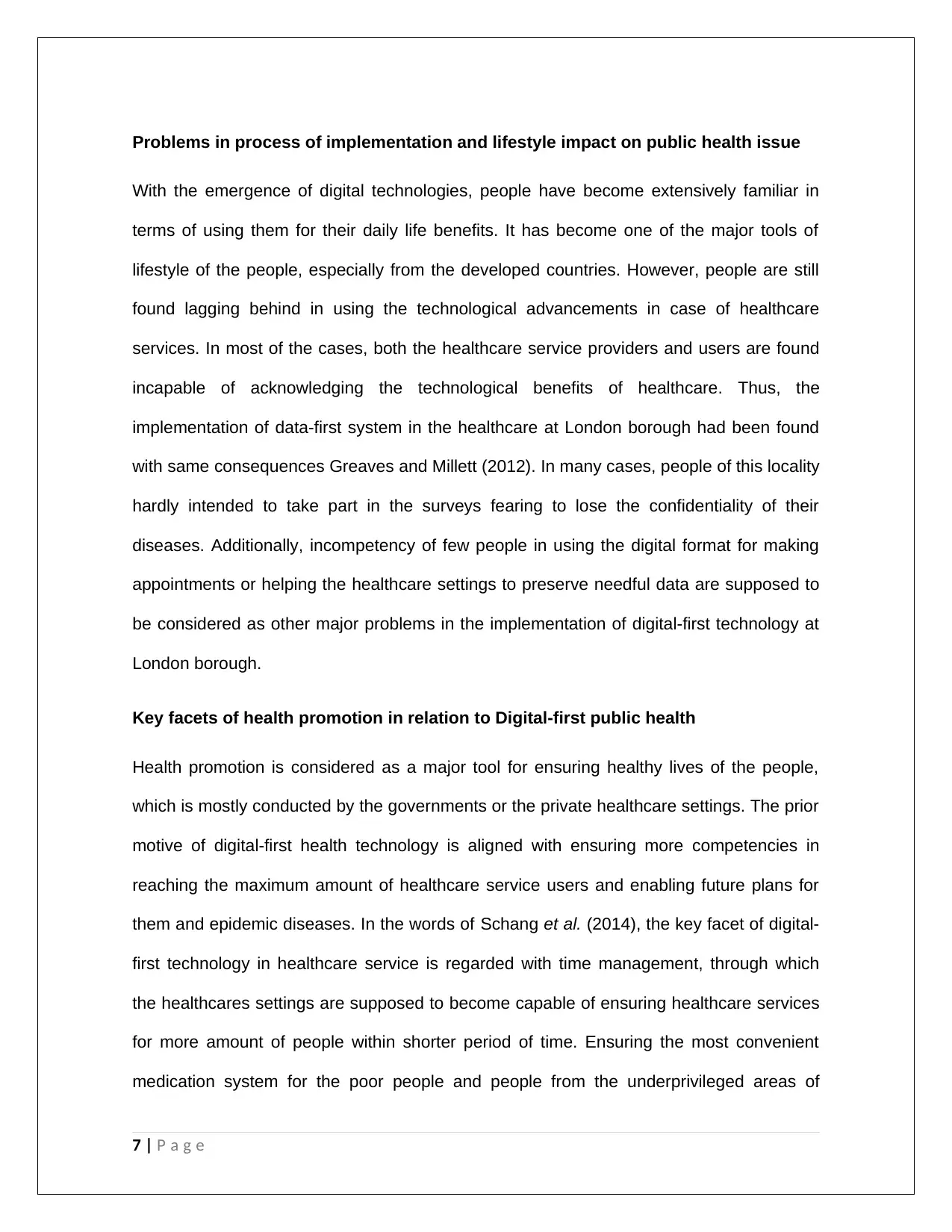
Problems in process of implementation and lifestyle impact on public health issue
With the emergence of digital technologies, people have become extensively familiar in
terms of using them for their daily life benefits. It has become one of the major tools of
lifestyle of the people, especially from the developed countries. However, people are still
found lagging behind in using the technological advancements in case of healthcare
services. In most of the cases, both the healthcare service providers and users are found
incapable of acknowledging the technological benefits of healthcare. Thus, the
implementation of data-first system in the healthcare at London borough had been found
with same consequences Greaves and Millett (2012). In many cases, people of this locality
hardly intended to take part in the surveys fearing to lose the confidentiality of their
diseases. Additionally, incompetency of few people in using the digital format for making
appointments or helping the healthcare settings to preserve needful data are supposed to
be considered as other major problems in the implementation of digital-first technology at
London borough.
Key facets of health promotion in relation to Digital-first public health
Health promotion is considered as a major tool for ensuring healthy lives of the people,
which is mostly conducted by the governments or the private healthcare settings. The prior
motive of digital-first health technology is aligned with ensuring more competencies in
reaching the maximum amount of healthcare service users and enabling future plans for
them and epidemic diseases. In the words of Schang et al. (2014), the key facet of digital-
first technology in healthcare service is regarded with time management, through which
the healthcares settings are supposed to become capable of ensuring healthcare services
for more amount of people within shorter period of time. Ensuring the most convenient
medication system for the poor people and people from the underprivileged areas of
7 | P a g e
With the emergence of digital technologies, people have become extensively familiar in
terms of using them for their daily life benefits. It has become one of the major tools of
lifestyle of the people, especially from the developed countries. However, people are still
found lagging behind in using the technological advancements in case of healthcare
services. In most of the cases, both the healthcare service providers and users are found
incapable of acknowledging the technological benefits of healthcare. Thus, the
implementation of data-first system in the healthcare at London borough had been found
with same consequences Greaves and Millett (2012). In many cases, people of this locality
hardly intended to take part in the surveys fearing to lose the confidentiality of their
diseases. Additionally, incompetency of few people in using the digital format for making
appointments or helping the healthcare settings to preserve needful data are supposed to
be considered as other major problems in the implementation of digital-first technology at
London borough.
Key facets of health promotion in relation to Digital-first public health
Health promotion is considered as a major tool for ensuring healthy lives of the people,
which is mostly conducted by the governments or the private healthcare settings. The prior
motive of digital-first health technology is aligned with ensuring more competencies in
reaching the maximum amount of healthcare service users and enabling future plans for
them and epidemic diseases. In the words of Schang et al. (2014), the key facet of digital-
first technology in healthcare service is regarded with time management, through which
the healthcares settings are supposed to become capable of ensuring healthcare services
for more amount of people within shorter period of time. Ensuring the most convenient
medication system for the poor people and people from the underprivileged areas of
7 | P a g e
Paraphrase This Document
Need a fresh take? Get an instant paraphrase of this document with our AI Paraphraser
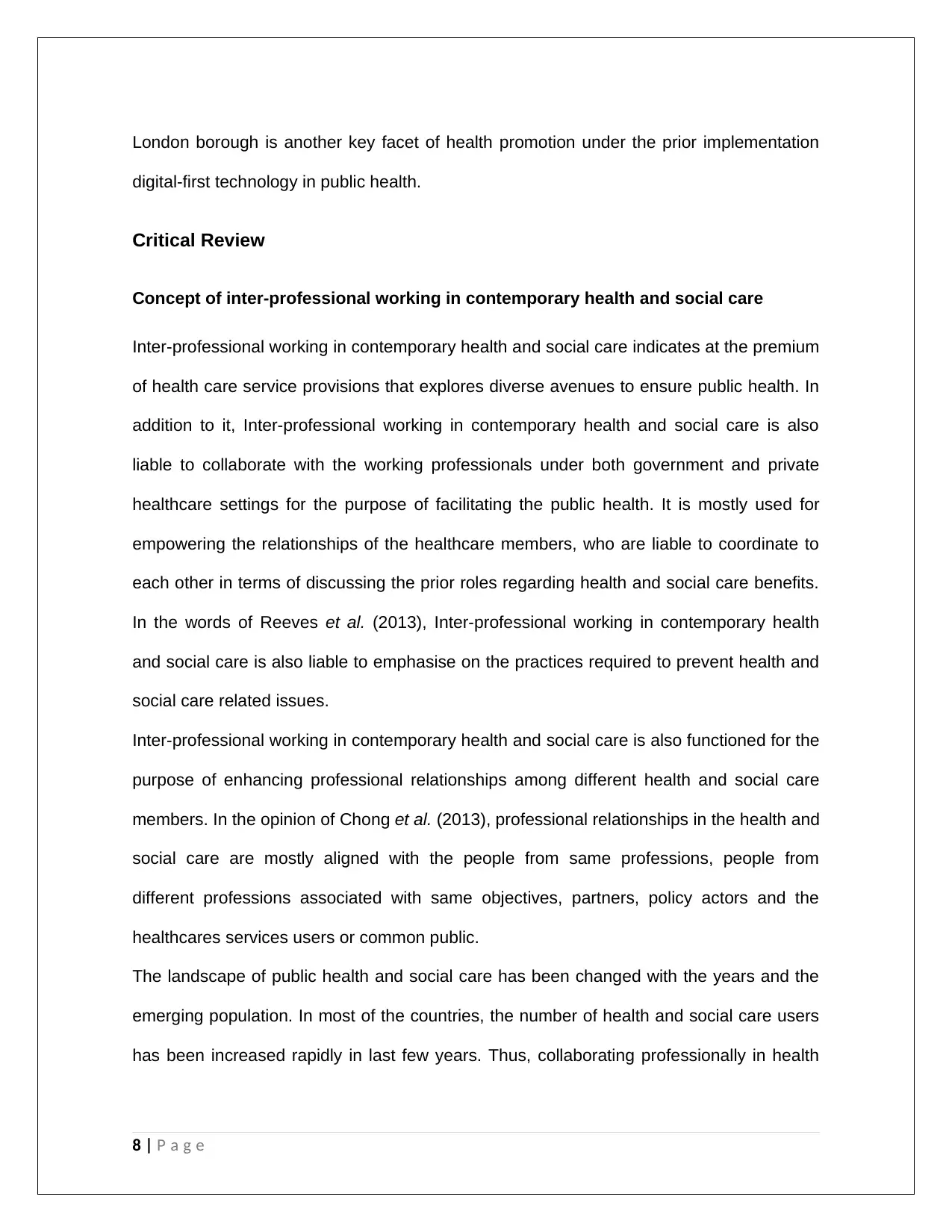
London borough is another key facet of health promotion under the prior implementation
digital-first technology in public health.
Critical Review
Concept of inter-professional working in contemporary health and social care
Inter-professional working in contemporary health and social care indicates at the premium
of health care service provisions that explores diverse avenues to ensure public health. In
addition to it, Inter-professional working in contemporary health and social care is also
liable to collaborate with the working professionals under both government and private
healthcare settings for the purpose of facilitating the public health. It is mostly used for
empowering the relationships of the healthcare members, who are liable to coordinate to
each other in terms of discussing the prior roles regarding health and social care benefits.
In the words of Reeves et al. (2013), Inter-professional working in contemporary health
and social care is also liable to emphasise on the practices required to prevent health and
social care related issues.
Inter-professional working in contemporary health and social care is also functioned for the
purpose of enhancing professional relationships among different health and social care
members. In the opinion of Chong et al. (2013), professional relationships in the health and
social care are mostly aligned with the people from same professions, people from
different professions associated with same objectives, partners, policy actors and the
healthcares services users or common public.
The landscape of public health and social care has been changed with the years and the
emerging population. In most of the countries, the number of health and social care users
has been increased rapidly in last few years. Thus, collaborating professionally in health
8 | P a g e
digital-first technology in public health.
Critical Review
Concept of inter-professional working in contemporary health and social care
Inter-professional working in contemporary health and social care indicates at the premium
of health care service provisions that explores diverse avenues to ensure public health. In
addition to it, Inter-professional working in contemporary health and social care is also
liable to collaborate with the working professionals under both government and private
healthcare settings for the purpose of facilitating the public health. It is mostly used for
empowering the relationships of the healthcare members, who are liable to coordinate to
each other in terms of discussing the prior roles regarding health and social care benefits.
In the words of Reeves et al. (2013), Inter-professional working in contemporary health
and social care is also liable to emphasise on the practices required to prevent health and
social care related issues.
Inter-professional working in contemporary health and social care is also functioned for the
purpose of enhancing professional relationships among different health and social care
members. In the opinion of Chong et al. (2013), professional relationships in the health and
social care are mostly aligned with the people from same professions, people from
different professions associated with same objectives, partners, policy actors and the
healthcares services users or common public.
The landscape of public health and social care has been changed with the years and the
emerging population. In most of the countries, the number of health and social care users
has been increased rapidly in last few years. Thus, collaborating professionally in health
8 | P a g e
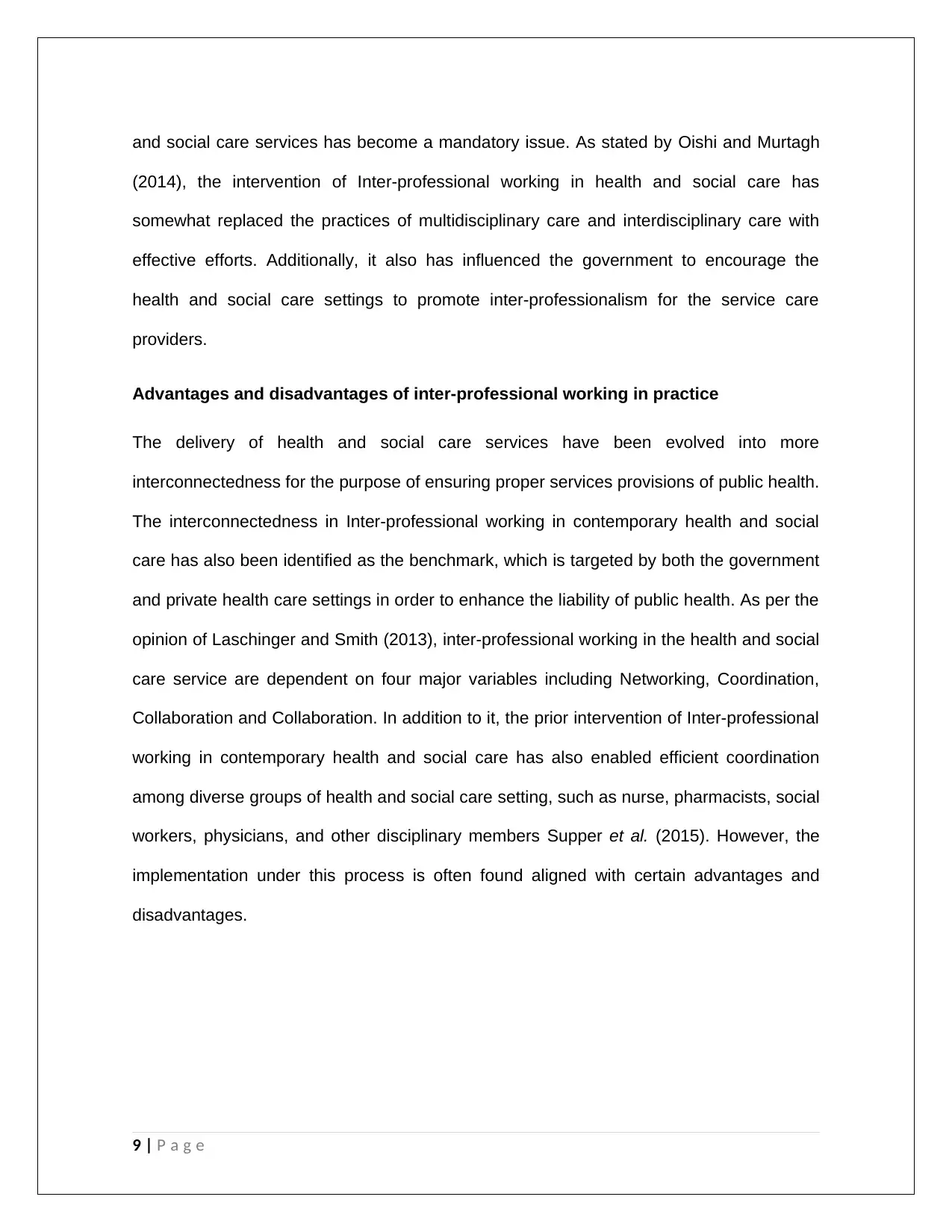
and social care services has become a mandatory issue. As stated by Oishi and Murtagh
(2014), the intervention of Inter-professional working in health and social care has
somewhat replaced the practices of multidisciplinary care and interdisciplinary care with
effective efforts. Additionally, it also has influenced the government to encourage the
health and social care settings to promote inter-professionalism for the service care
providers.
Advantages and disadvantages of inter-professional working in practice
The delivery of health and social care services have been evolved into more
interconnectedness for the purpose of ensuring proper services provisions of public health.
The interconnectedness in Inter-professional working in contemporary health and social
care has also been identified as the benchmark, which is targeted by both the government
and private health care settings in order to enhance the liability of public health. As per the
opinion of Laschinger and Smith (2013), inter-professional working in the health and social
care service are dependent on four major variables including Networking, Coordination,
Collaboration and Collaboration. In addition to it, the prior intervention of Inter-professional
working in contemporary health and social care has also enabled efficient coordination
among diverse groups of health and social care setting, such as nurse, pharmacists, social
workers, physicians, and other disciplinary members Supper et al. (2015). However, the
implementation under this process is often found aligned with certain advantages and
disadvantages.
9 | P a g e
(2014), the intervention of Inter-professional working in health and social care has
somewhat replaced the practices of multidisciplinary care and interdisciplinary care with
effective efforts. Additionally, it also has influenced the government to encourage the
health and social care settings to promote inter-professionalism for the service care
providers.
Advantages and disadvantages of inter-professional working in practice
The delivery of health and social care services have been evolved into more
interconnectedness for the purpose of ensuring proper services provisions of public health.
The interconnectedness in Inter-professional working in contemporary health and social
care has also been identified as the benchmark, which is targeted by both the government
and private health care settings in order to enhance the liability of public health. As per the
opinion of Laschinger and Smith (2013), inter-professional working in the health and social
care service are dependent on four major variables including Networking, Coordination,
Collaboration and Collaboration. In addition to it, the prior intervention of Inter-professional
working in contemporary health and social care has also enabled efficient coordination
among diverse groups of health and social care setting, such as nurse, pharmacists, social
workers, physicians, and other disciplinary members Supper et al. (2015). However, the
implementation under this process is often found aligned with certain advantages and
disadvantages.
9 | P a g e
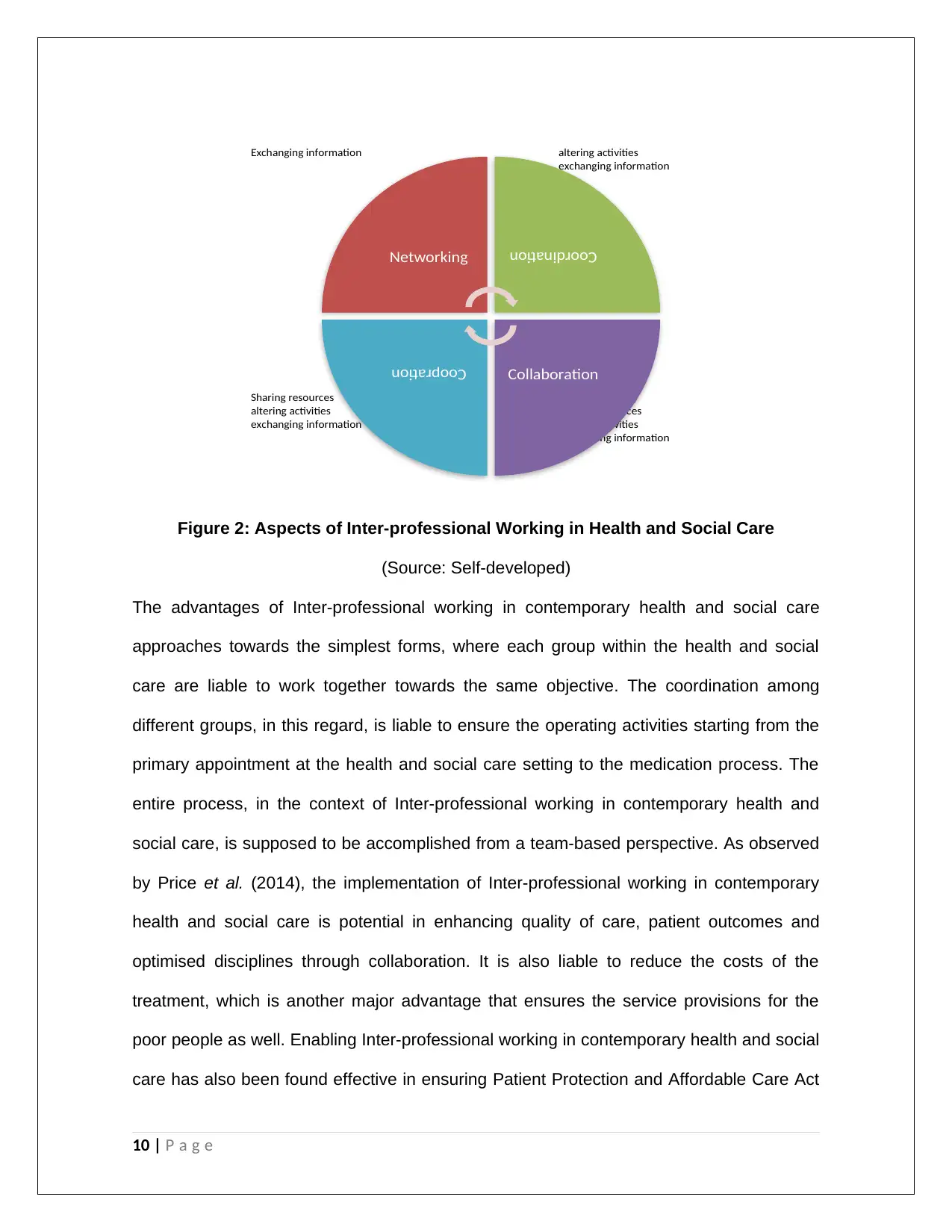
Figure 2: Aspects of Inter-professional Working in Health and Social Care
(Source: Self-developed)
The advantages of Inter-professional working in contemporary health and social care
approaches towards the simplest forms, where each group within the health and social
care are liable to work together towards the same objective. The coordination among
different groups, in this regard, is liable to ensure the operating activities starting from the
primary appointment at the health and social care setting to the medication process. The
entire process, in the context of Inter-professional working in contemporary health and
social care, is supposed to be accomplished from a team-based perspective. As observed
by Price et al. (2014), the implementation of Inter-professional working in contemporary
health and social care is potential in enhancing quality of care, patient outcomes and
optimised disciplines through collaboration. It is also liable to reduce the costs of the
treatment, which is another major advantage that ensures the service provisions for the
poor people as well. Enabling Inter-professional working in contemporary health and social
care has also been found effective in ensuring Patient Protection and Affordable Care Act
10 | P a g e
Enhancing ability
Sharing resources
altering activities
exchanging information
Sharing resources
altering activities
exchanging information
altering activities
exchanging information
Exchanging information
Networking
Coordination
Collaboration Coopration
(Source: Self-developed)
The advantages of Inter-professional working in contemporary health and social care
approaches towards the simplest forms, where each group within the health and social
care are liable to work together towards the same objective. The coordination among
different groups, in this regard, is liable to ensure the operating activities starting from the
primary appointment at the health and social care setting to the medication process. The
entire process, in the context of Inter-professional working in contemporary health and
social care, is supposed to be accomplished from a team-based perspective. As observed
by Price et al. (2014), the implementation of Inter-professional working in contemporary
health and social care is potential in enhancing quality of care, patient outcomes and
optimised disciplines through collaboration. It is also liable to reduce the costs of the
treatment, which is another major advantage that ensures the service provisions for the
poor people as well. Enabling Inter-professional working in contemporary health and social
care has also been found effective in ensuring Patient Protection and Affordable Care Act
10 | P a g e
Enhancing ability
Sharing resources
altering activities
exchanging information
Sharing resources
altering activities
exchanging information
altering activities
exchanging information
Exchanging information
Networking
Coordination
Collaboration Coopration
Secure Best Marks with AI Grader
Need help grading? Try our AI Grader for instant feedback on your assignments.

of 2010 in UK (healthcare.gov. 2017). Furthermore, the acknowledgement of this act under
the process of Inter-professional working in contemporary health and social care also
sheds light on emphasising the health and social care provisions for the poor as well.
Disadvantages of Inter-professional working in contemporary health and social care, on
the other hand, are associated with fewer instances. Complexities and lack of knowledge
on the working premises of each group within the health and social care setting had been
observed as the major challenges in the implementation process of Inter-professional
working in contemporary health and social care. In the words of Orchard et al. (2012), lack
of conclusive evidence is another major disadvantage, for which this process is often
discarded or rejected by the health and social care settings fearing about the possible
failure. Additionally, the objectivity of Inter-professional working is supposed to be learnt
from the minor ages, from where the basic educations are adopted. One can hardly adopt
it suddenly prioritising the team-based objectives. Thus, it often becomes extensively
difficult for the other participants within the collaboration, once they find some persons are
not in a way towards inter-professional working.
Outlining national policies that recommend inter-professional working
The implementation process of inter-professional working has been identified as a major
concern for both the government and private health and social care settings in the UK.
Thus, it is meant to be acknowledged by the professional for ensuring enhanced provision
of health and social care. With the prior assessment on the benefits of inter-professional
working in the health and social care, the government of the UK has prioritised it for the
utilisation by all the health and social care settings, especially in the underprivileged areas
of the country. As observed by Chong et al. (2013), the inter-professional working in health
and social care has also been included within the national policy of the UK under the
11 | P a g e
the process of Inter-professional working in contemporary health and social care also
sheds light on emphasising the health and social care provisions for the poor as well.
Disadvantages of Inter-professional working in contemporary health and social care, on
the other hand, are associated with fewer instances. Complexities and lack of knowledge
on the working premises of each group within the health and social care setting had been
observed as the major challenges in the implementation process of Inter-professional
working in contemporary health and social care. In the words of Orchard et al. (2012), lack
of conclusive evidence is another major disadvantage, for which this process is often
discarded or rejected by the health and social care settings fearing about the possible
failure. Additionally, the objectivity of Inter-professional working is supposed to be learnt
from the minor ages, from where the basic educations are adopted. One can hardly adopt
it suddenly prioritising the team-based objectives. Thus, it often becomes extensively
difficult for the other participants within the collaboration, once they find some persons are
not in a way towards inter-professional working.
Outlining national policies that recommend inter-professional working
The implementation process of inter-professional working has been identified as a major
concern for both the government and private health and social care settings in the UK.
Thus, it is meant to be acknowledged by the professional for ensuring enhanced provision
of health and social care. With the prior assessment on the benefits of inter-professional
working in the health and social care, the government of the UK has prioritised it for the
utilisation by all the health and social care settings, especially in the underprivileged areas
of the country. As observed by Chong et al. (2013), the inter-professional working in health
and social care has also been included within the national policy of the UK under the
11 | P a g e

provision of ‘working together for better future. This has enabled the health and social care
settings of the UK to acknowledge the benefits earned from the implementation process of
inter-professional working in the health and social care.
Inter-professional collaborative practice has been prioritised by the World Health
Organisation as well, which insisted the national governments to incorporate this practice
within their health and social care sector. The prior motive of inter-professional working in
health and social care settings is to ensure respect, shared decision-making, trust, and
partnerships among all the members associated with it. In addition to it Chung et al.
(2012), the inter-professional competency domain also includes certain acknowledgements
in terms of ensuring health benefits for both the poor and rich health social care users.
These acknowledgements include collaborative leadership, role clarification, inter-
professional communication, inter-professional conflict resolution, team functioning, patient
centred care (Currie and White, 2012). With the active intervention of the World Health
Organisation, the Government of the UK has also amended this implementation into
practices under the Health and Social Care Act 2012 (legislation.gov.uk. 2017).
Reviewing applied factors with effectiveness in achieving Digital-first ambition
Inter-professional working has been found extensively useful for both the direct and
indirect approaches for health and social care services. It is evident that the collaborative
practices in health and social care eventually enhance the credibility of each health and
service provider group in ensuring the proper services. However, the collaborative
practices also emphasise on indirect health and social care services as well, which are
found equally essential for the health and social care practices. In many cases, it has been
found that the government of the countries are emphasising on the practices of Inter-
professional working in order to reach the maximum numbers of health and service care
12 | P a g e
settings of the UK to acknowledge the benefits earned from the implementation process of
inter-professional working in the health and social care.
Inter-professional collaborative practice has been prioritised by the World Health
Organisation as well, which insisted the national governments to incorporate this practice
within their health and social care sector. The prior motive of inter-professional working in
health and social care settings is to ensure respect, shared decision-making, trust, and
partnerships among all the members associated with it. In addition to it Chung et al.
(2012), the inter-professional competency domain also includes certain acknowledgements
in terms of ensuring health benefits for both the poor and rich health social care users.
These acknowledgements include collaborative leadership, role clarification, inter-
professional communication, inter-professional conflict resolution, team functioning, patient
centred care (Currie and White, 2012). With the active intervention of the World Health
Organisation, the Government of the UK has also amended this implementation into
practices under the Health and Social Care Act 2012 (legislation.gov.uk. 2017).
Reviewing applied factors with effectiveness in achieving Digital-first ambition
Inter-professional working has been found extensively useful for both the direct and
indirect approaches for health and social care services. It is evident that the collaborative
practices in health and social care eventually enhance the credibility of each health and
service provider group in ensuring the proper services. However, the collaborative
practices also emphasise on indirect health and social care services as well, which are
found equally essential for the health and social care practices. In many cases, it has been
found that the government of the countries are emphasising on the practices of Inter-
professional working in order to reach the maximum numbers of health and service care
12 | P a g e
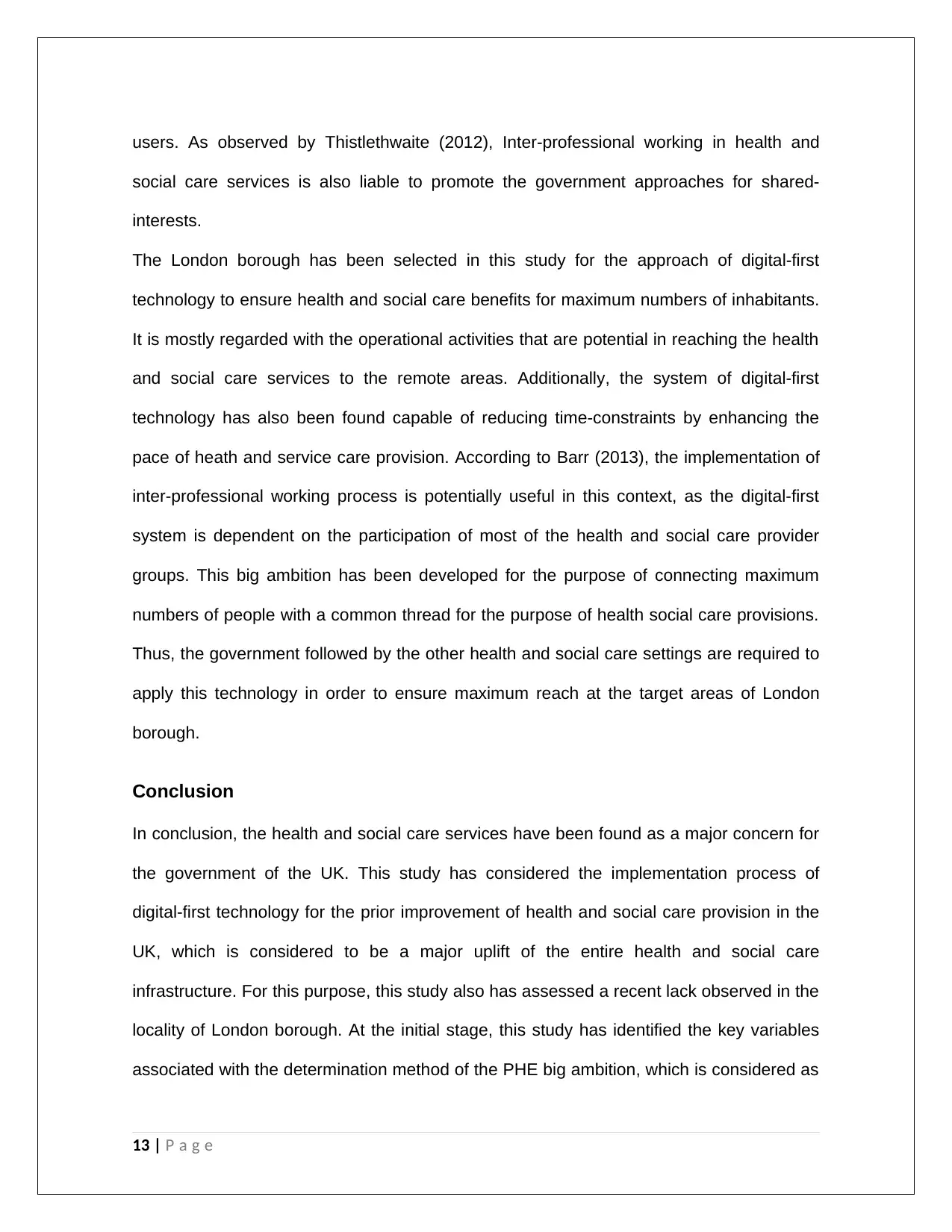
users. As observed by Thistlethwaite (2012), Inter-professional working in health and
social care services is also liable to promote the government approaches for shared-
interests.
The London borough has been selected in this study for the approach of digital-first
technology to ensure health and social care benefits for maximum numbers of inhabitants.
It is mostly regarded with the operational activities that are potential in reaching the health
and social care services to the remote areas. Additionally, the system of digital-first
technology has also been found capable of reducing time-constraints by enhancing the
pace of heath and service care provision. According to Barr (2013), the implementation of
inter-professional working process is potentially useful in this context, as the digital-first
system is dependent on the participation of most of the health and social care provider
groups. This big ambition has been developed for the purpose of connecting maximum
numbers of people with a common thread for the purpose of health social care provisions.
Thus, the government followed by the other health and social care settings are required to
apply this technology in order to ensure maximum reach at the target areas of London
borough.
Conclusion
In conclusion, the health and social care services have been found as a major concern for
the government of the UK. This study has considered the implementation process of
digital-first technology for the prior improvement of health and social care provision in the
UK, which is considered to be a major uplift of the entire health and social care
infrastructure. For this purpose, this study also has assessed a recent lack observed in the
locality of London borough. At the initial stage, this study has identified the key variables
associated with the determination method of the PHE big ambition, which is considered as
13 | P a g e
social care services is also liable to promote the government approaches for shared-
interests.
The London borough has been selected in this study for the approach of digital-first
technology to ensure health and social care benefits for maximum numbers of inhabitants.
It is mostly regarded with the operational activities that are potential in reaching the health
and social care services to the remote areas. Additionally, the system of digital-first
technology has also been found capable of reducing time-constraints by enhancing the
pace of heath and service care provision. According to Barr (2013), the implementation of
inter-professional working process is potentially useful in this context, as the digital-first
system is dependent on the participation of most of the health and social care provider
groups. This big ambition has been developed for the purpose of connecting maximum
numbers of people with a common thread for the purpose of health social care provisions.
Thus, the government followed by the other health and social care settings are required to
apply this technology in order to ensure maximum reach at the target areas of London
borough.
Conclusion
In conclusion, the health and social care services have been found as a major concern for
the government of the UK. This study has considered the implementation process of
digital-first technology for the prior improvement of health and social care provision in the
UK, which is considered to be a major uplift of the entire health and social care
infrastructure. For this purpose, this study also has assessed a recent lack observed in the
locality of London borough. At the initial stage, this study has identified the key variables
associated with the determination method of the PHE big ambition, which is considered as
13 | P a g e
Paraphrase This Document
Need a fresh take? Get an instant paraphrase of this document with our AI Paraphraser
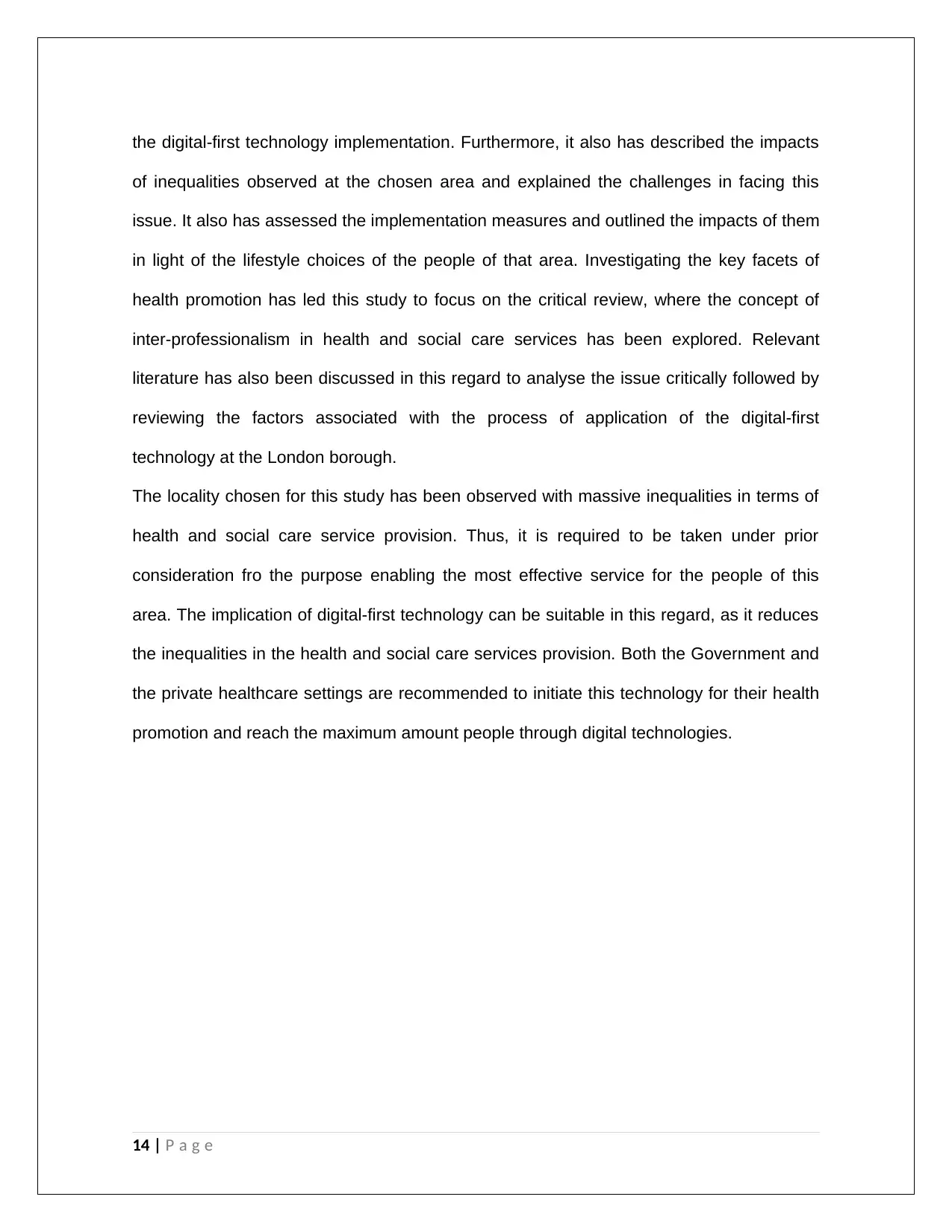
the digital-first technology implementation. Furthermore, it also has described the impacts
of inequalities observed at the chosen area and explained the challenges in facing this
issue. It also has assessed the implementation measures and outlined the impacts of them
in light of the lifestyle choices of the people of that area. Investigating the key facets of
health promotion has led this study to focus on the critical review, where the concept of
inter-professionalism in health and social care services has been explored. Relevant
literature has also been discussed in this regard to analyse the issue critically followed by
reviewing the factors associated with the process of application of the digital-first
technology at the London borough.
The locality chosen for this study has been observed with massive inequalities in terms of
health and social care service provision. Thus, it is required to be taken under prior
consideration fro the purpose enabling the most effective service for the people of this
area. The implication of digital-first technology can be suitable in this regard, as it reduces
the inequalities in the health and social care services provision. Both the Government and
the private healthcare settings are recommended to initiate this technology for their health
promotion and reach the maximum amount people through digital technologies.
14 | P a g e
of inequalities observed at the chosen area and explained the challenges in facing this
issue. It also has assessed the implementation measures and outlined the impacts of them
in light of the lifestyle choices of the people of that area. Investigating the key facets of
health promotion has led this study to focus on the critical review, where the concept of
inter-professionalism in health and social care services has been explored. Relevant
literature has also been discussed in this regard to analyse the issue critically followed by
reviewing the factors associated with the process of application of the digital-first
technology at the London borough.
The locality chosen for this study has been observed with massive inequalities in terms of
health and social care service provision. Thus, it is required to be taken under prior
consideration fro the purpose enabling the most effective service for the people of this
area. The implication of digital-first technology can be suitable in this regard, as it reduces
the inequalities in the health and social care services provision. Both the Government and
the private healthcare settings are recommended to initiate this technology for their health
promotion and reach the maximum amount people through digital technologies.
14 | P a g e
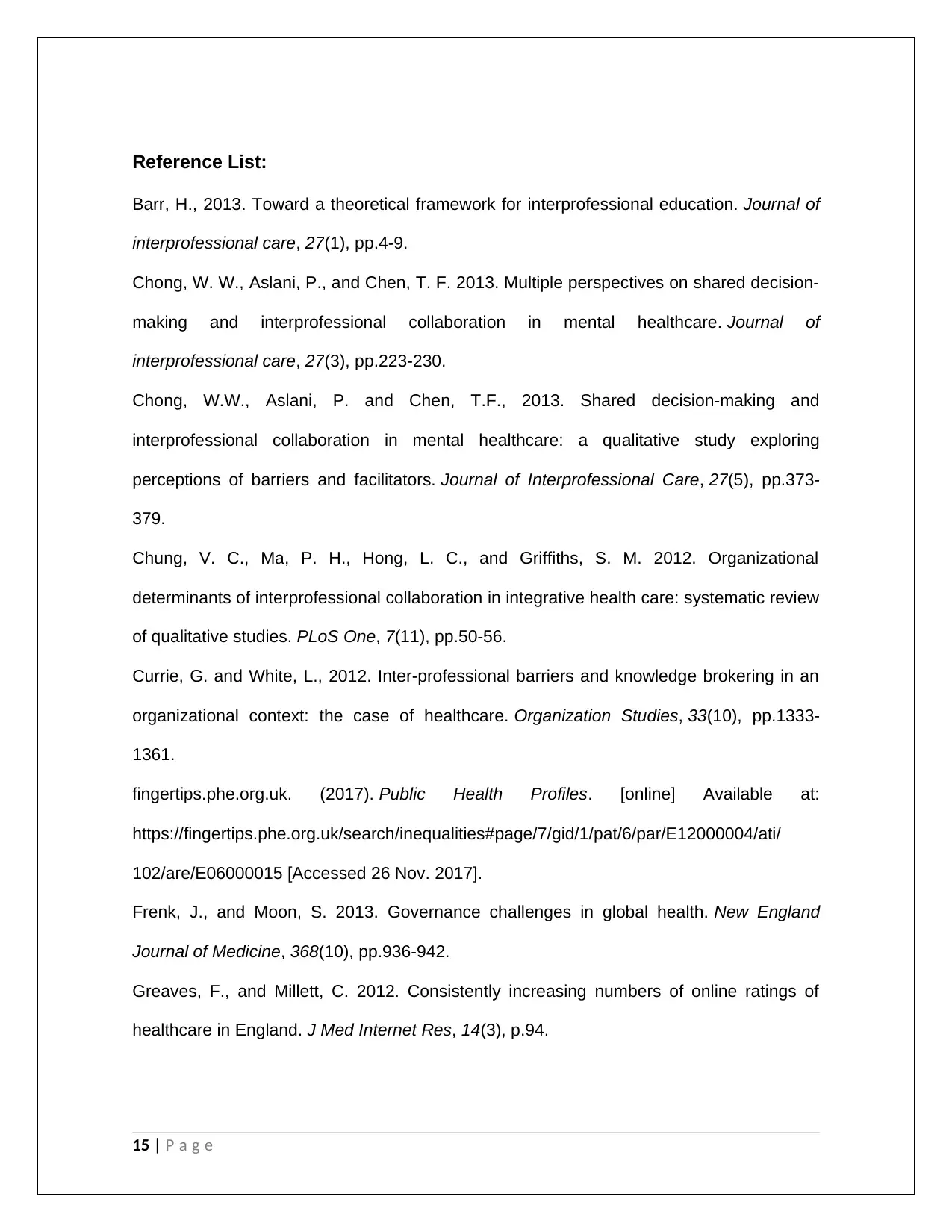
Reference List:
Barr, H., 2013. Toward a theoretical framework for interprofessional education. Journal of
interprofessional care, 27(1), pp.4-9.
Chong, W. W., Aslani, P., and Chen, T. F. 2013. Multiple perspectives on shared decision-
making and interprofessional collaboration in mental healthcare. Journal of
interprofessional care, 27(3), pp.223-230.
Chong, W.W., Aslani, P. and Chen, T.F., 2013. Shared decision-making and
interprofessional collaboration in mental healthcare: a qualitative study exploring
perceptions of barriers and facilitators. Journal of Interprofessional Care, 27(5), pp.373-
379.
Chung, V. C., Ma, P. H., Hong, L. C., and Griffiths, S. M. 2012. Organizational
determinants of interprofessional collaboration in integrative health care: systematic review
of qualitative studies. PLoS One, 7(11), pp.50-56.
Currie, G. and White, L., 2012. Inter-professional barriers and knowledge brokering in an
organizational context: the case of healthcare. Organization Studies, 33(10), pp.1333-
1361.
fingertips.phe.org.uk. (2017). Public Health Profiles. [online] Available at:
https://fingertips.phe.org.uk/search/inequalities#page/7/gid/1/pat/6/par/E12000004/ati/
102/are/E06000015 [Accessed 26 Nov. 2017].
Frenk, J., and Moon, S. 2013. Governance challenges in global health. New England
Journal of Medicine, 368(10), pp.936-942.
Greaves, F., and Millett, C. 2012. Consistently increasing numbers of online ratings of
healthcare in England. J Med Internet Res, 14(3), p.94.
15 | P a g e
Barr, H., 2013. Toward a theoretical framework for interprofessional education. Journal of
interprofessional care, 27(1), pp.4-9.
Chong, W. W., Aslani, P., and Chen, T. F. 2013. Multiple perspectives on shared decision-
making and interprofessional collaboration in mental healthcare. Journal of
interprofessional care, 27(3), pp.223-230.
Chong, W.W., Aslani, P. and Chen, T.F., 2013. Shared decision-making and
interprofessional collaboration in mental healthcare: a qualitative study exploring
perceptions of barriers and facilitators. Journal of Interprofessional Care, 27(5), pp.373-
379.
Chung, V. C., Ma, P. H., Hong, L. C., and Griffiths, S. M. 2012. Organizational
determinants of interprofessional collaboration in integrative health care: systematic review
of qualitative studies. PLoS One, 7(11), pp.50-56.
Currie, G. and White, L., 2012. Inter-professional barriers and knowledge brokering in an
organizational context: the case of healthcare. Organization Studies, 33(10), pp.1333-
1361.
fingertips.phe.org.uk. (2017). Public Health Profiles. [online] Available at:
https://fingertips.phe.org.uk/search/inequalities#page/7/gid/1/pat/6/par/E12000004/ati/
102/are/E06000015 [Accessed 26 Nov. 2017].
Frenk, J., and Moon, S. 2013. Governance challenges in global health. New England
Journal of Medicine, 368(10), pp.936-942.
Greaves, F., and Millett, C. 2012. Consistently increasing numbers of online ratings of
healthcare in England. J Med Internet Res, 14(3), p.94.
15 | P a g e
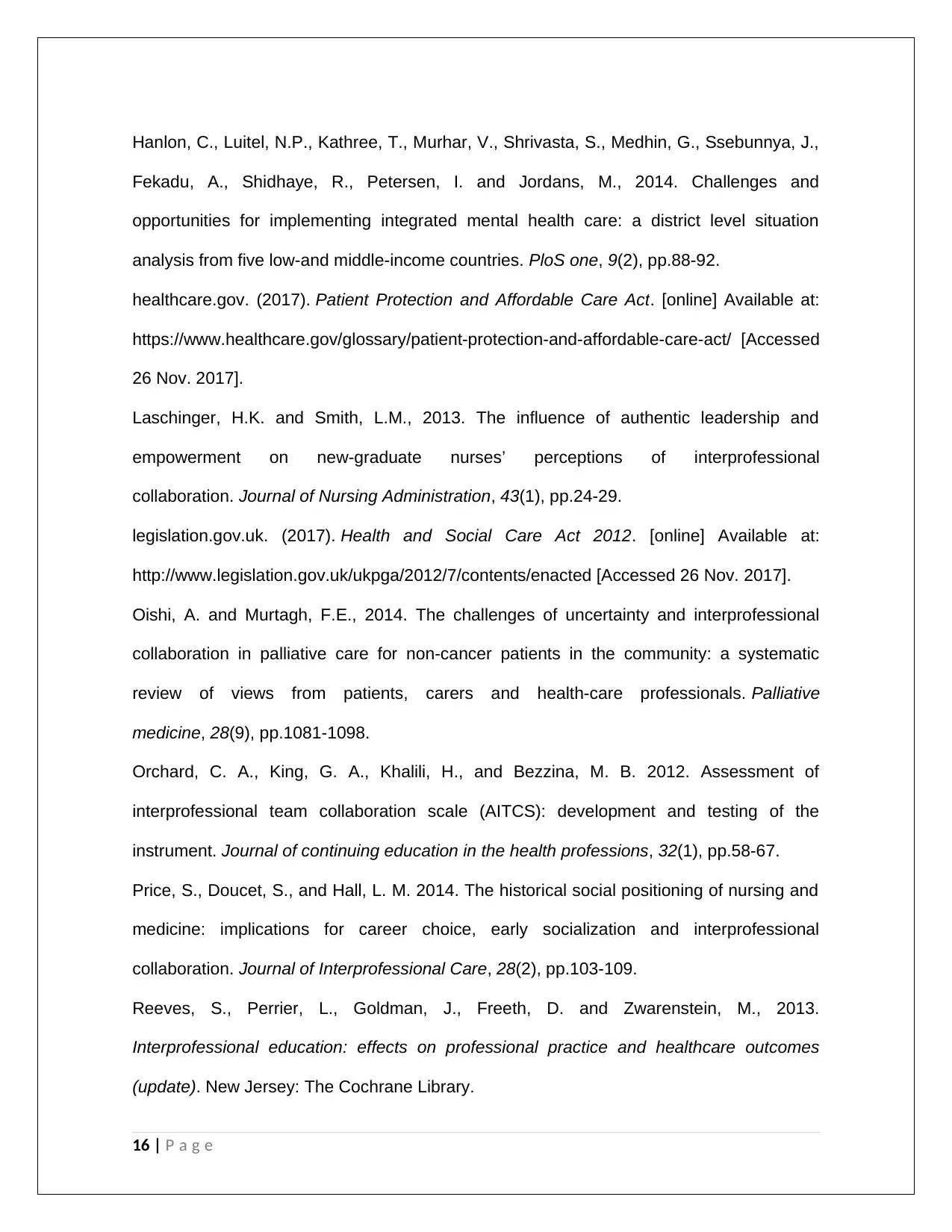
Hanlon, C., Luitel, N.P., Kathree, T., Murhar, V., Shrivasta, S., Medhin, G., Ssebunnya, J.,
Fekadu, A., Shidhaye, R., Petersen, I. and Jordans, M., 2014. Challenges and
opportunities for implementing integrated mental health care: a district level situation
analysis from five low-and middle-income countries. PloS one, 9(2), pp.88-92.
healthcare.gov. (2017). Patient Protection and Affordable Care Act. [online] Available at:
https://www.healthcare.gov/glossary/patient-protection-and-affordable-care-act/ [Accessed
26 Nov. 2017].
Laschinger, H.K. and Smith, L.M., 2013. The influence of authentic leadership and
empowerment on new-graduate nurses’ perceptions of interprofessional
collaboration. Journal of Nursing Administration, 43(1), pp.24-29.
legislation.gov.uk. (2017). Health and Social Care Act 2012. [online] Available at:
http://www.legislation.gov.uk/ukpga/2012/7/contents/enacted [Accessed 26 Nov. 2017].
Oishi, A. and Murtagh, F.E., 2014. The challenges of uncertainty and interprofessional
collaboration in palliative care for non-cancer patients in the community: a systematic
review of views from patients, carers and health-care professionals. Palliative
medicine, 28(9), pp.1081-1098.
Orchard, C. A., King, G. A., Khalili, H., and Bezzina, M. B. 2012. Assessment of
interprofessional team collaboration scale (AITCS): development and testing of the
instrument. Journal of continuing education in the health professions, 32(1), pp.58-67.
Price, S., Doucet, S., and Hall, L. M. 2014. The historical social positioning of nursing and
medicine: implications for career choice, early socialization and interprofessional
collaboration. Journal of Interprofessional Care, 28(2), pp.103-109.
Reeves, S., Perrier, L., Goldman, J., Freeth, D. and Zwarenstein, M., 2013.
Interprofessional education: effects on professional practice and healthcare outcomes
(update). New Jersey: The Cochrane Library.
16 | P a g e
Fekadu, A., Shidhaye, R., Petersen, I. and Jordans, M., 2014. Challenges and
opportunities for implementing integrated mental health care: a district level situation
analysis from five low-and middle-income countries. PloS one, 9(2), pp.88-92.
healthcare.gov. (2017). Patient Protection and Affordable Care Act. [online] Available at:
https://www.healthcare.gov/glossary/patient-protection-and-affordable-care-act/ [Accessed
26 Nov. 2017].
Laschinger, H.K. and Smith, L.M., 2013. The influence of authentic leadership and
empowerment on new-graduate nurses’ perceptions of interprofessional
collaboration. Journal of Nursing Administration, 43(1), pp.24-29.
legislation.gov.uk. (2017). Health and Social Care Act 2012. [online] Available at:
http://www.legislation.gov.uk/ukpga/2012/7/contents/enacted [Accessed 26 Nov. 2017].
Oishi, A. and Murtagh, F.E., 2014. The challenges of uncertainty and interprofessional
collaboration in palliative care for non-cancer patients in the community: a systematic
review of views from patients, carers and health-care professionals. Palliative
medicine, 28(9), pp.1081-1098.
Orchard, C. A., King, G. A., Khalili, H., and Bezzina, M. B. 2012. Assessment of
interprofessional team collaboration scale (AITCS): development and testing of the
instrument. Journal of continuing education in the health professions, 32(1), pp.58-67.
Price, S., Doucet, S., and Hall, L. M. 2014. The historical social positioning of nursing and
medicine: implications for career choice, early socialization and interprofessional
collaboration. Journal of Interprofessional Care, 28(2), pp.103-109.
Reeves, S., Perrier, L., Goldman, J., Freeth, D. and Zwarenstein, M., 2013.
Interprofessional education: effects on professional practice and healthcare outcomes
(update). New Jersey: The Cochrane Library.
16 | P a g e
Secure Best Marks with AI Grader
Need help grading? Try our AI Grader for instant feedback on your assignments.
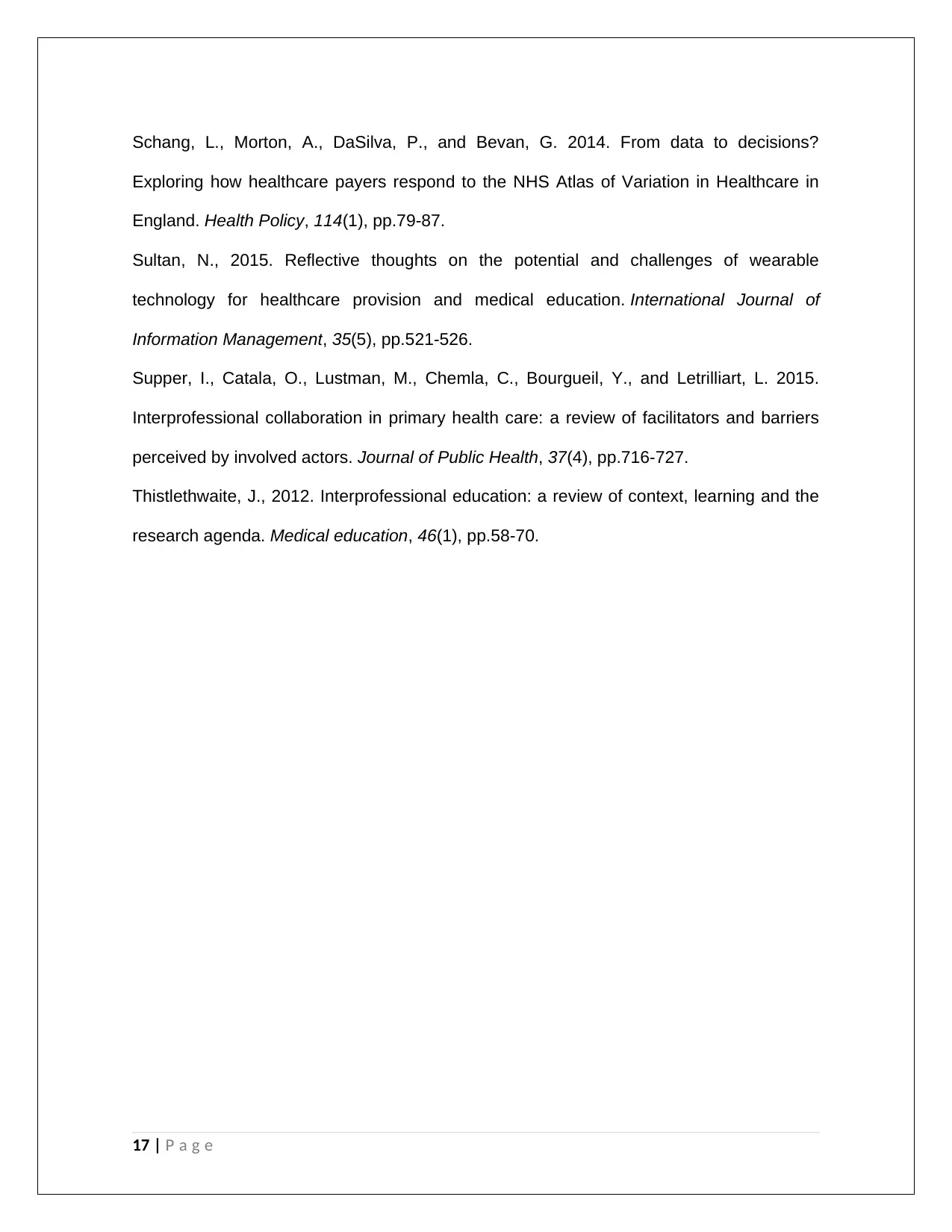
Schang, L., Morton, A., DaSilva, P., and Bevan, G. 2014. From data to decisions?
Exploring how healthcare payers respond to the NHS Atlas of Variation in Healthcare in
England. Health Policy, 114(1), pp.79-87.
Sultan, N., 2015. Reflective thoughts on the potential and challenges of wearable
technology for healthcare provision and medical education. International Journal of
Information Management, 35(5), pp.521-526.
Supper, I., Catala, O., Lustman, M., Chemla, C., Bourgueil, Y., and Letrilliart, L. 2015.
Interprofessional collaboration in primary health care: a review of facilitators and barriers
perceived by involved actors. Journal of Public Health, 37(4), pp.716-727.
Thistlethwaite, J., 2012. Interprofessional education: a review of context, learning and the
research agenda. Medical education, 46(1), pp.58-70.
17 | P a g e
Exploring how healthcare payers respond to the NHS Atlas of Variation in Healthcare in
England. Health Policy, 114(1), pp.79-87.
Sultan, N., 2015. Reflective thoughts on the potential and challenges of wearable
technology for healthcare provision and medical education. International Journal of
Information Management, 35(5), pp.521-526.
Supper, I., Catala, O., Lustman, M., Chemla, C., Bourgueil, Y., and Letrilliart, L. 2015.
Interprofessional collaboration in primary health care: a review of facilitators and barriers
perceived by involved actors. Journal of Public Health, 37(4), pp.716-727.
Thistlethwaite, J., 2012. Interprofessional education: a review of context, learning and the
research agenda. Medical education, 46(1), pp.58-70.
17 | P a g e
1 out of 17
Related Documents
Your All-in-One AI-Powered Toolkit for Academic Success.
+13062052269
info@desklib.com
Available 24*7 on WhatsApp / Email
![[object Object]](/_next/static/media/star-bottom.7253800d.svg)
Unlock your academic potential
© 2024 | Zucol Services PVT LTD | All rights reserved.




